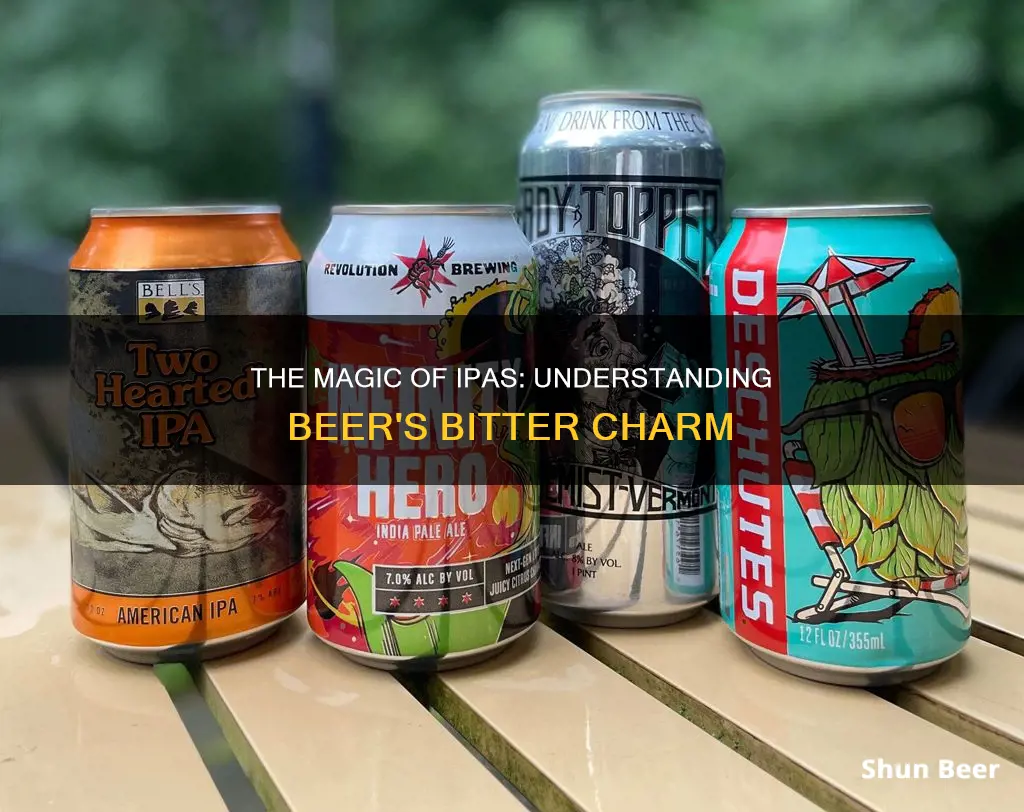
India Pale Ale, or IPA, is a style of beer that falls under the broader category of pale ales. IPAs are characterised by a higher concentration of hops, higher alcohol content, and higher IBUs (international bittering units) when compared to other beers. The term IPA covers a wide range of substyles, including West Coast IPAs, New England-style IPAs, Session IPAs, and Triple IPAs, each with its own unique characteristics. The history of IPAs can be traced back to the 1700s when British brewers added extra hops to their beers to preserve them during long voyages to India, giving rise to the name India Pale Ale.
What You'll Learn

IPA stands for India Pale Ale
India Pale Ale, or IPA, is a style of beer that falls under the broader category of pale ales. IPAs are known for their strong hoppy character, higher alcohol content, and more intense flavours compared to other beers. The name "India Pale Ale" originates from the beer's historical connection to the British colonies in India during the 1700s and 1800s.
The story goes that British soldiers and workers in the East India Trading Company craved the beer from back home but faced challenges in getting it to the colonies. The beer often arrived stale or contaminated after months of travel by sea. British brewers experimented with various methods to address this issue, and eventually, George Hodgson from Bow Brewery in London found a solution by adding extra hops to a beer called October Ale. The additional hops helped preserve the beer, and the result was a brew that not only lasted the journey but also developed a flavour that was well-liked by the soldiers.
Over time, the IPA evolved and became popular in both Britain and India for its refreshing balance of fruity sweetness and bitter hops. However, its popularity waned after the First World War. It was not until the 1970s, with the emergence of the craft beer movement in the USA, that IPAs began to regain their prominence.
Today, IPAs come in various styles, such as West Coast IPAs, New England-style IPAs, Session IPAs, and Triple IPAs, each offering unique flavour profiles and varying levels of bitterness, alcohol content, and intensity. While the specific characteristics of an IPA can differ depending on the brewer's methods and ingredients, the defining feature remains the prominent use of hops, which sets it apart from other types of beer.
Marble Magic: Guinness Beer's Signature Swirl
You may want to see also

IPAs have more hops than pale ales
IPAs, or India Pale Ales, were first created in the 1800s for British soldiers stationed in India. The beer was designed to survive the long journey from England to India, so brewers added extra hops, which act as a preservative. This resulted in a beer with a stronger, more bitter taste than the British were used to.
The key difference between IPAs and pale ales is that IPAs have bigger hop flavours and slightly higher ABV (alcohol by volume). Pale ales typically range from 4.5% to 6.2% ABV, while IPAs usually fall between 5% and 7.5%, or higher for a double IPA.
IPAs are known for their strong hop flavours and aromas, resulting in a more bitter taste than pale ales. The additional hops in IPAs contribute to both the increased bitterness and the higher alcohol content.
Pale ales, on the other hand, are characterised by a more balanced flavour profile. They still have a noticeable hop presence, but it is not as dominant as in IPAs. Pale ales tend to have more subtle bread notes and a lighter drinking experience due to their lower ABV.
While IPAs and pale ales share some similarities in appearance and fermentation processes, they are distinct styles of beer. The main differences lie in the bitterness and alcohol content, with IPAs offering a bolder, more intense drinking experience.
Guinness Beer's Thick Con: Why the Creamy, Dark Con?
You may want to see also

Hops are a natural preservative
India Pale Ales (IPAs) are a type of beer that came about in the 1800s, when British brewers looked to adjust their production methods to address the problem of beer exports to India arriving stale and contaminated after months at sea. The solution was to add more hops as a natural preservative, which would also increase the alcohol content and the intensity of the flavour, while extending the life of the beer for up to 6 months.
Hops are flowers, usually dried, that are used as flavouring in beer. They are a natural preservative, and their preservative qualities are due to isohumulone, which disrupts the membranes of lactobacilli. The preservative qualities of hops are also attributed to an unknown factor, which for now is referred to as "factor X". Factor X is directly related to the amount of hops used, and not the amount of alpha acids.
The Belgians knew that using too many hops would result in an undesirable vegetative flavour, so they would dry out hops in the sun to remove the bittering and vegetative (chlorophyll) elements, and then add the bleached-out hops to the boil to preserve the beer without adding bitterness.
The long journey to India turned out to improve the quality and taste of IPAs, which quickly became a hit in both Britain and India. IPAs are known for their refreshing balance of fruity sweetness and bitter hops.
Booze in Beer: IPAs Boomsauce Alcoholic Secrets
You may want to see also

IPAs have a higher ABV than pale ales
India Pale Ales (IPAs) and pale ales are both extremely popular types of beer, and while they share many similarities, there are some distinct differences between the two. Both beers are known for their hoppy flavour profiles, but IPAs tend to have bigger hop flavours and slightly higher alcohol by volume (ABV). Pale ales usually have an ABV of 4.5%–6.2%, while IPAs typically range from 5%–7.5% ABV, or even higher for a double IPA.
IPAs were first created in the 1800s as a variation of the pale ale, which originated in England in the 1700s. British brewers added more hops and malt to pale ales to create IPAs that could withstand the long journey from England to India, and still taste fresh upon arrival. The extra hops and malt not only preserved the beer but also resulted in a stronger, more bitter taste with fruity aromas.
The higher ABV in IPAs is due to the increased amount of hops and malt used in the brewing process. Hops are natural preservatives, so adding more hops to the beer helped to maintain its flavour and freshness during long-distance travel. The higher ABV also contributed to the longer shelf life of IPAs, making them ideal for export.
Today, IPAs remain a wildly popular style of beer, with a wide variety of substyles available, such as Session IPAs, Double IPAs, and Hazy IPAs. While modern IPAs may not have the same level of hoppy bitterness as their historical counterparts, they still offer a stronger, more intense flavour profile compared to pale ales.
The Many Points of IPA Beer
You may want to see also

IPAs have a stronger flavour than pale ales
India Pale Ales (IPAs) are a type of beer that falls under the broader category of pale ales. While both types of beer have a lot in common, there are some key differences that give IPAs a stronger flavour than pale ales.
Firstly, IPAs tend to be more hop-heavy than pale ales. Hops are a natural preservative, and IPAs were originally brewed with higher levels of hops to ensure they could withstand the long journey from England to India without spoiling. This higher concentration of hops gives IPAs a stronger, more bitter taste than pale ales, which are known for having a more balanced flavour.
Secondly, IPAs typically have a higher alcohol content than pale ales. The extra hops added to IPAs increase the alcohol content and intensity of the flavour. Pale ales, on the other hand, have a lower alcohol content, contributing to their lighter, more delicate taste.
Another factor that contributes to the stronger flavour of IPAs is the presence of fruity aromas. IPAs are known for their fruity and citrusy notes, which add to the overall intensity of the beer. Pale ales, while they may have some fruity flavours, tend to rely more on their malts for flavour and have more bread-like notes.
Finally, IPAs have a drier mouthfeel and a stronger aftertaste than pale ales. This is due to the higher concentration of hops and alcohol in IPAs, which leaves a more lasting impression on the palate.
In conclusion, while both IPAs and pale ales are popular styles of beer with similar characteristics, IPAs generally have a stronger flavour due to their higher hop content, increased alcohol content, fruity aromas, and more intense aftertaste.
IPA Beer: English Style, Explained
You may want to see also
Frequently asked questions
IPA stands for India Pale Ale.
IPAs are a type of pale ale with a higher concentration of hops, a higher alcohol content, and higher IBUs (international bittering units).
IPAs can have a harsher hops flavour, often balanced by strong notes of citrus and earthy or floral tones. They can also have floral and resinous notes, and creative dry-hopping has helped infuse IPAs with everything from mango and guava character to hints of fresh-cut cedar and marijuana.







